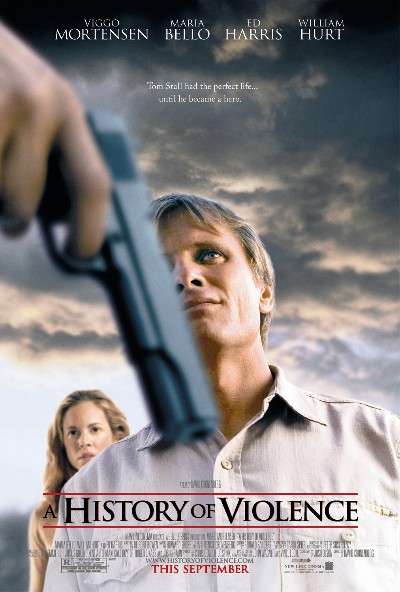A History of Violence review by The Grim Ringler
A History of Violence
It’s not often
that director David Cronenberg gets
the kind of ink he’s been getting with this film, as he’s always worked on the
fringes of the film world. Sure, he has his admirers in the critic pool, but
his films can be so bleak and cold that a lot of people are immediately put off
by them and don’t see past his weird fetishistic themes. Of late he has been
plumbing the depths of what makes humans animals – madness and murder in Spider – and now rage and violence in A History… What is interesting is that
this is a project that uses the idea of violence and rage atop an emotional
distance, to create a world that is like a twisted mirror of our own. This is
reality…but it’s reality in the darkest of ways. Where everyone has a secret.
The trouble for Tom Stall begins when two strangers
appear in his small town café looking for some quick cash, no matter who gets
hurt. Professional ‘bad men’, there is no way to defuse the situation despite
Tom’s efforts to manage things and to give them what they want, so bad turns to
worse and Tom has no choice to but act. In acting Tom kills both men and
becomes an overnight celebrity and ‘American Hero’. Tom is none to happy with
the exposure, save that it boosts business briefly, but his fame has another
effect in that it brings more strangers to town, this time in the form of the
mafia who are looking for someone they swear is Tom. They insist that Tom is
really Joey from Philly and that he was notorious for his brutality and skills
with murder. Tom tries to convince them that he isn’t this man, this murderer
from their past, but they don’t buy it, and despite threats from Tom’s wife (a
lawyer), and from the local sheriff, the men persist in their pursuit of Tom.
And it would seem that that first act of violence has burst a dam and suddenly
this small town that has been so quiet is about to become the setting for
violence like it’s never seen before and may never see again. And as the mafia
men keep pushing Tom to admit who he is, his wife begins to wonder how well she
really knows this man she’s been with for over seventeen years.
Slow and deliberate, this is a film that builds on
everything Cronenberg has done
previously and hones it to a fine point. The film is very quiet, the small town
atmosphere settling the nerves after an early act of violence that sets the
tone for what is to come, but we are lulled into comfort as the story of this
family man unfolds. The film works so well at lulling you into a feeling of safety
so that when the violence reappears, its brutality is utterly shocking and
continues to be shocking as the each act unfolds. Even the sex, during one
scene, leaves the viewer feeling exposed and vulnerable, the sheer hate and
anger behind it making it almost a scene of mutual rape. The real horror is in
how the violence affects those around Tom, his family stretching and tearing
beneath the weight of what he has become a part of.
The film shows its graphic novel origins in the story, as
it gets wilder and more intense, but Cronenberg
ties it all back to the family so that, wherever the story goes, the family is
still what it comes back to. The biggest flaw is the overacting of William Hurt who chews scenery like it’s
so much popcorn. He doesn’t ruin the film, but he changes the dynamic of the
scenes he is in. Viggo Mortensen
plays it straight, and I am very curious as to his approach, which I cannot
reveal, lest I give something away, but Hurt
really hams it up and it’s not for the films betterment.
This is a terrific film, and it really came together for
me with the finale, which was very powerful. Without this ending, the film
loses its beauty, and horror, and is just another of a long line of films
purporting to say something but that really use that message as a way to
further exploit the topic. The worst violence you will see in this film, is the
violence you do not see, the emotional violence.
Great movie.
…c…








8 out of 10 Jackasses blog comments powered by Disqus
